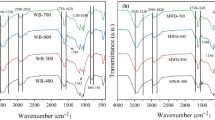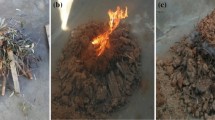Abstract
A real industrial effluent from the pre-treatment and painting processes was polished through adsorption using alternative biochar derived from grape pomace wastes. The biochar was produced in a pilot-scale plant from composted grape pomace. Biochar showed an equilibrium between acidic and basic groups on the surface. The presence of irregular cavities in the structure and mesopores was confirmed by analyzing N2 physisorption and SEM. Concerning the effluent, Ni and Zn were the main problematic elements. The adsorption isotherms and kinetics of Ni and Zn from the effluent using the biochar could be represented by the Henry, pseudo-first-order, and pseudo-second-order models, respectively. Adsorption equilibrium was reached within 60 min for Ni and Zn present in the real effluent. Besides, the adsorption process was endothermic, favorable, and spontaneous. These results demonstrate that Zn and Ni metals were successfully removed from the industrial effluent, presenting final concentration values within the limit of legislation for effluent disposal in agricultural soil.







Similar content being viewed by others
Data availability
The datasets used and analyzed during the current study are available from the corresponding author on reasonable request.
References
Ahmad M, Lee SS, Dou X, Mohan D, Sung J-K, Yang JE, Ok YS (2012) Effects of pyrolysis temperature on soybean stover- and peanut shell-derived biochar properties and TCE adsorption in water. Bioresour Technol 118:536–544. https://doi.org/10.1016/j.biortech.2012.05.042
Al-Lagtah NMA, Al-Muhtaseb AH, Ahmad MNM, Salameh Y (2016) Chemical and physical characteristics of optimal synthesized activated carbons from grass-derived sulfonated lignin versus commercial activated carbon. Micropor Mesopor Mat 225:504–514. https://doi.org/10.1016/j.micromeso.2016.01.043
Anirudhan TS, Sreekumari SS (2011) Adsorptive removal of heavy metal ions from industrial effluents using activated carbon derived from waste coconut buttons. J Environ Sci (china) 23:1989–1998. https://doi.org/10.1016/S1001-0742(10)60515-3
Bilal M, Shah JA, Ashfaq T, Gardazi SMH, Tahir AA, Pervez A, Haroon H, Mahmood Q (2013) Waste biomass adsorbents for copper removal from industrial wastewater—a review. J Hazard Mater 263:322–333. https://doi.org/10.1016/j.jhazmat.2013.07.071
Bonilla-Petriciolet, A., Mendoza-Castillo, D.I., Dotto, G.L., Duran-Valle, C.J. 2019. 1 ed. Adsorption in water treatment. Reference module in chemistry, molecular sciences and chemical engineering 1 Elsevier, Amsterdam, pp. 1–21. https://doi.org/10.1016/B978-0-12-409547-2.14390-2
Brezoiu AM, Matei C, Deaconu M, Stanciuc AM, Trifan A, Pintiliescu AG, Berger D (2019) Polyphenols extract from grape pomace. Characterization and valorisation through encapsulation into mesoporous silica-type matrices. Food Chem Toxicol 133:110787. https://doi.org/10.1016/j.fct.2019.110787
Cao X, Harris W (2010) Properties of dairy-manure-derived biochar pertinent to its potential use in remediation. Bioresour Technol 101:5222–5228. https://doi.org/10.1016/j.biortech.2010.02.052
Cao X, Ma L, Liang Y, Gao B, Harris W (2011) Simultaneous immobilization of lead and atrazine in contaminated soils using dairy-manure biochar. Environ Sci Technol 45:4884–4889. https://doi.org/10.1021/es103752u
Casazza AA, Aliakbarian B, Lagazzo A, Garbarino G, Carnasciali MM, Perego P, Busca G (2016) Pyrolysis of grape marc before and after the recovery of polyphenol fraction. Fuel Process Technol 153:121–128. https://doi.org/10.1016/j.fuproc.2016.07.014
Dil EA, Ghaedi M, Asfaram A, Mehrabi F, Sadeghfar F (2019) Efficient adsorption of azure B onto CNTs/Zn:ZnO@Ni2P-NCs from aqueous solution in the presence of ultrasound wave based on multivariate optimization. J Ind Eng Chem 74:55–62. https://doi.org/10.1016/j.jiec.2018.12.050
Dotto GL, McKay G (2020) Current scenario and challenges in adsorption for water treatment. J Environ Chem Eng 8:103988. https://doi.org/10.1016/j.jece.2020.103988
Dotto, G.L., Salau, N.P.G., Piccin, J.S., Cadaval Jr., T.R.S., Pinto, L.A.A. 2017. Adsorption kinetics in liquid phase: modeling for discontinuous and continuous systems, Chapter 3, In: A. Bonilla-Petriciolet, D.I. Mendoza-Castillo, H.E. Reynel-Ávila (Eds.), Adsorption processes for water treatment and purification, Springer International Publishing. https://doi.org/10.1007/978-3-319-58136-1_3
Dotto GL, Vieira MLG, Gonçalves JO, Pinto LAA (2011) Removal of acid blue 9, food yellow 3 and fd&c yellow n° 5 dyes from aqueous solutions using activated carbon, activated earth, diatomaceous earth, chitin and chitosan: equilibrium studies and thermodynamic. Quím Nova 34:1193–1199. https://doi.org/10.1590/s0100-40422011000700017
Fan X, Gao Y, He W, Hu H, Tian M, Wang K, Pan S (2016) Production of nano bacterial cellulose from beverage industrial waste of citrus peel and pomace using Komagataeibacter xylinus. Carbohydr Polym 151:1068–1072. https://doi.org/10.1016/j.carbpol.2016.06.062
Ferrari V, Taffarel SR, Espinosa-Fuentes E, Oliveira MLS, Saikia BK, Silva LFO (2019) Chemical evaluation of by-products of the grape industry as potential agricultural fertilizers. J Clean Prod 208:297–306. https://doi.org/10.1016/j.jclepro.2018.10.032
Georgin J, de Salomón YIO, Franco DSP, Netto MS, Piccilli DGA, Perondi D, Silva LFO, Foletto EL, Dotto GL (2021) Development of highly porous activated carbon from Jacaranda mimosifolia seed pods for remarkable removal of aqueous-phase ketoprofen. J Environ Chem Eng 9:105676. https://doi.org/10.1016/j.jece.2021.105676
González-García P (2018) Activated carbon from lignocellulosics precursors: a review of the synthesis methods, characterization techniques and applications. Renew Sust Energ Rev 82:1393–1414. https://doi.org/10.1016/j.rser.2017.04.117
Gope, M., Saha, R. 2021. Removal of heavy metals from industrial effluents by using biochar, Intelligent Environmental Data Monitoring for Pollution Management, p. 25–48. https://doi.org/10.1016/B978-0-12-819671-7.00002-6.
Jiang K, Liu K, Peng Q, Zhou M (2021) Adsorption of Pb(II) and Zn(II) ions on humus-like substances modified montmorillonite. Colloids Surf, A Physicochem Eng Asp 631:127706. https://doi.org/10.1016/j.colsurfa.2021.127706
Kayalvizhi K, Alhaji NMI, Saravanakkumar D, Mohamed SB, Kaviyarasu K, Ayeshamariam A, Al-Mohaimeed AM, AbdelGawwad MR, Elshikh MS (2022) Adsorption of copper and nickel by using sawdust chitosan nanocomposite beads A kinetic and thermodynamic study. Environ Res 203:111814. https://doi.org/10.1016/j.envres.2021.111814
Li H, Xiong J, Xiao T, Long J, Wang Q, Li K, Liu X, Zhang G, Zhang H (2019) Biochar derived from watermelon rinds as regenerable adsorbent for efficient removal of thallium(I) from wastewater. Process Saf Environ Prot 257–266. https://doi.org/10.1016/j.psep.2019.04.031
Li ZY, Azi F, Dong JJ, Liu LZ, Ge ZW, Dong MS (2021) Green and efficient in-situ biosynthesis of antioxidant and antibacterial bacterial cellulose using wine pomace. Int J Biol Macromol. https://doi.org/10.1016/j.ijbiomac.2021.11.049.
Lima EC, Hosseini-Bandegharaei A, Moreno-Piraján JC, Anastopoulos I (2019) A critical review of the estimation of the thermodynamic parameters on adsorption equilibria. Wrong use of equilibrium constant in the Van’t Hoof equation for calculation of thermodynamic parameters of adsorption. J Mol Liq 273:425–434. https://doi.org/10.1016/j.molliq.2018.10.048
Lütke SF, Igansi AV, Pegoraro L, Dotto GL, Pinto LAA, Cadaval Jr TRS (2019) Preparation of activated carbon from black wattle bark waste and its application for phenol adsorption. J Environ Chem Eng 7:103396. https://doi.org/10.1016/j.jece:2019.103396
Mulinari DR, Voorwald HJC, Cioffi MO, Silva MLCP, Luz SM (2009) Preparation and properties of HDPE/sugarcane bagasse cellulose composites obtained for thermokinetic mixer. Carbohydr Polym 75:317–321. https://doi.org/10.1016/j.carbpol.2008.07.028
Netto MS, Rossato DL, Jahn SL, Mallmann ES, Dotto GL, Foletto EL 2019 Preparation of a novel magnetic geopolymer/zero–valent iron composite with remarkable adsorption performance towards aqueous Acid Red 97. Chem Eng Commun 1048-1061. https://doi.org/10.1080/00986445.2019.1635467
Oncel MS, Muhcu A, Demirbas E, Kobya M (2013) A comparative study of chemical precipitation and electrocoagulation for treatment of coal acid drainage wastewater. J Environ Chem Eng 1:989–995. https://doi.org/10.1016/j.jece.2013.08.008
Peng L, Bartzas G 2021 Heavy metals and metalloids: a serious threat to environment and human health. Curr Opin Environ Sci Health Editorial overview, 23, Article 100287. https://doi.org/10.1016/j.coesh.2021.100287.
Peres EC, Cunha JM, Dortzbacher GF, Pavan FA, Lima EC, Foletto EL, Dotto GL (2018) Treatment of leachates containing cobalt by adsorption on Spirulina sp. and activated charcoal. J Environ Chem Eng 6:677–685. https://doi.org/10.1016/j.jece.2017.12.060
Piccin JS, Cadaval Jr., TRS, Pinto LAA, Dotto GL 2017 Adsorption isotherms in liquid phase: experimental, modeling, and interpretations, Chapter 2, in: A. Bonilla-Petriciolet, D.I. Mendoza-Castillo, H.E. Reynel-Ávila (Eds.), Adsorption processes for water treatment and purification, Springer International Publishing. Adsorption. https://doi.org/10.1007/978-3-319-58136-1_2
Pigatto RS, Franco DSP, Netto MS, Carissimi É, Oliveira LFS, Jahn SL, Dotto GL 2020 An eco-friendly and low-cost strategy for groundwater defluorination: adsorption of fluoride onto calcinated sludge. J Environ Chem Eng Article 104546. https://doi.org/10.1016/j.jece.2020.104546
Rathi BS, Kumar PS 2021 Application of adsorption process for effective removal of emerging contaminants from water and wastewater. Environ Pollut 280, Article 116995. https://doi.org/10.1016/j.envpol.2021.116995.
Rosa SMC, Nossol ABS, Nossol E, Zarbin AJG, Zamora PGP 2017 Non-synergistic UV-A photocatalytic degradation of estrogens by nano-TiO2 supported on activated carbon. J Braz Chem Soc 28.https://doi.org/10.5935/0103-5053.20160201
Rossato DL, Netto MS, Jahn SL, Mallman ES, Dotto GL, Foletto EL (2020) Highly efficient adsorption performance of a novel magnetic geopolymer/Fe3O4 composite towards removal of aqueous acid green 16 dye. J Environ Chem Eng 8:103804. https://doi.org/10.1016/j.jece.2020.103804
Roy A, Bharadvaja N (2021) Efficient removal of heavy metals from artificial wastewater using biochar. Environ Nanotechnol Monit Manag. https://doi.org/10.1016/j.enmm.2021.100602
Santos DCD, Adebayo MA, Lima EC, Pereira SFP, Cataluña R, Saucier C, Thue PS, Machado FM (2015) Application of carbon composite adsorbents prepared from coffee waste and clay for the removal of reactive dyes from aqueous solutions. J Braz Chem Soc 26:924–938. https://doi.org/10.5935/0103-5053.20150053
Sardella F, Gimenez M, Navas C, Morandi C, Deiana C, Sapang K (2015) Conversion of viticultural industry wastes into activated carbons for removal of lead and cadmium. J Environ Chem Eng 3:253–260. https://doi.org/10.1016/j.jece.2014.06.026
Shao L, Ren Z, Zhang G, Chen L (2012) Facile synthesis, characterization of a MnFe 2O 4/activated carbon magnetic composite and its effectiveness in tetracycline removal. Mater Chem Phys 135:16–24. https://doi.org/10.1016/j.matchemphys.2012.03.035
Silva NF, Netto MS, Silva LFO, Mallmann ES, Lima EC, Ferrari V, Dotto GL (2021) Composite carbon materials from winery composted waste for the treatment of effluents contaminated with ketoprofen and 2-nitrophenol. J Environ Chem Eng 9:105421. https://doi.org/10.1016/j.jece.2021.105421
Sing KSW, Everett DH, Haul RAW, Moscou L, Pieroti RA, Rouquerol J, Siemieniewska T (1985) Reporting physisorption data for gas/solid systems with special reference to the determination of surface area and porosity. Pure Appl Chem 57:603–619. https://doi.org/10.1351/pac198557040603
Streit AFM, Collazzo GC, Druzian SP, Verdi RS, Foletto EL, Oliveira LFS, Dotto GL (2021) Adsorption of ibuprofen, ketoprofen, and paracetamol onto activated carbon prepared from effluent treatment plant sludge of the beverage industry. Chemosphere 262:128322. https://doi.org/10.1016/j.chemosphere.2020.128322
Tang SH, Ahmad Zaini MA (2020) Development of activated carbon pellets using a facile low-cost binder for effective malachite green dye removal. J Cleaner Prod 253:119970. https://doi.org/10.1016/j.jclepro.2020.119970
Tareq R, Akter N, Azam MDS 2019 Biochars and biochar composites: low-cost adsorbents for environmental remediation. Biochar Biomass Waste 169-209. https://doi.org/10.1016/B978-0-12-811729-3.00010-8
Vilvanathan S, Shanthakumar S 2015 Biosorption of Co(II) ions from aqueous solution using Chrysanthemum indicum: kinetics, equilibrium and thermodynamics, Process Saf Environ Prot 98-110. https://doi.org/10.1016/j.psep.2015.05.001
Yang Q, Meng X, Zhao H, Cao C, Liu Y, Huisingh D (2021) Sustainable operations-oriented painting process optimisation in automobile maintenance service. J Clean Prod 324:129191. https://doi.org/10.1016/j.jclepro.2021.129191
Zhou G, Liu C, Chu L, Tang Y, Luo S (2016) Rapid and efficient treatment of wastewater with high-concentration heavy metals using a new type of hydrogel-based adsorption process. Bioresour Technol 219:451–457. https://doi.org/10.1016/j.biortech.2016.07.038
Funding
The authors would like to thank Coordination for the Improvement of Higher Education Personnel (CAPES) and National Council for Scientific and Technological Development (CNPq) for their financial support.
Author information
Authors and Affiliations
Contributions
Conceptualization, F. L. Carvalho, F. Ketzer, and G. L. Dotto; methodology, R. R. Schio and J. P. dos Santos; formal analysis and investigation, R. R. Schio and J. P. dos Santos; writing — original draft preparation, F. L. Carvalho, F. Ketzer, R. R. Schio, and J. P. dos Santos; writing — review and editing, G. L. Dotto, D. Pinto, and L. F. O. Silva; funding acquisition, G. L. Dotto and L. F. O. Silva; and supervision, G. L. Dotto. All authors read and approved the final manuscript.
Corresponding authors
Ethics declarations
Ethics approval
Not applicable.
Consent to participate
Not applicable.
Consent for publication
Not applicable.
Competing interests
The authors declare no competing interests.
Additional information
Responsible Editor: Zhihong Xu
Publisher's note
Springer Nature remains neutral with regard to jurisdictional claims in published maps and institutional affiliations.
Supplementary Information
Below is the link to the electronic supplementary material.
Rights and permissions
About this article
Cite this article
Carvalho, F.L., Pinto, D., Schio, R.R. et al. Polishing of painting process effluents through adsorption with biochar from winemaking residues. Environ Sci Pollut Res 29, 66348–66358 (2022). https://doi.org/10.1007/s11356-022-20488-4
Received:
Accepted:
Published:
Issue Date:
DOI: https://doi.org/10.1007/s11356-022-20488-4




